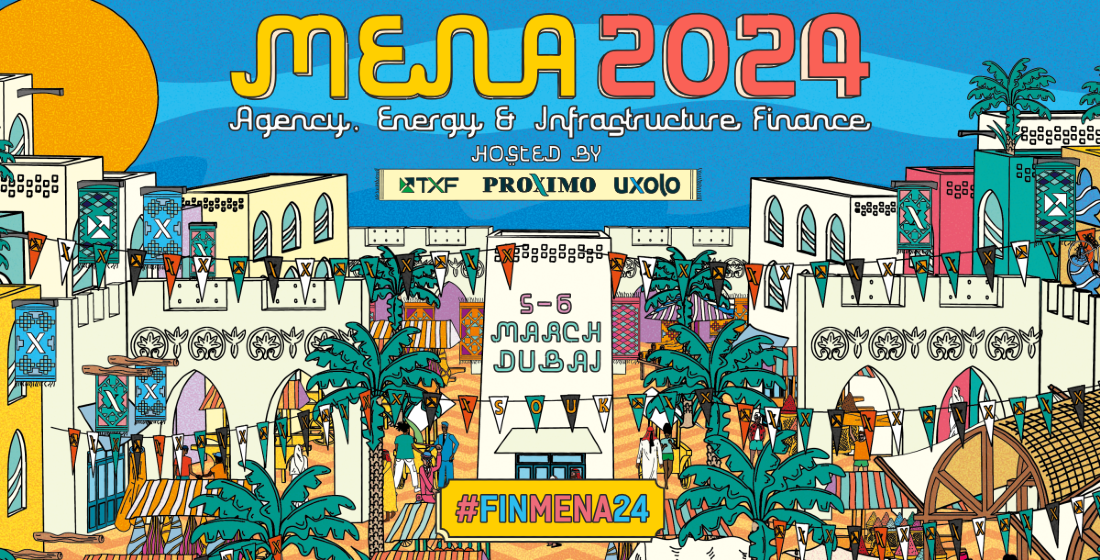TXF MENA 2024: Top takeaways
ECA-backed project finance took centre stage this year at TXF MENA 2024 with the spotlight on energy transition, longer tenors, and untied lending. ECA flexibility contributed to record debt volumes last year - but there is still room for improvement.

2023 was a banner year for export finance. But ECAs need to up support for exporters and borrowers in MENA to unlock more liquidity and help diversify the funding mix for big-ticket infrastructure schemes in the region despite volumes doubling from 2022. The Middle East accounted for $21.44 billion in 2023 (up from $9.5 billion in 2022).
ECAs are well placed to accelerate the diversification of MENA’s oil-dependent economies as their role in connecting borrowers with quality materials, critical minerals, and suppliers link with the push towards carbon neutrality. The ‘S’ in ESG was cited as being just as important as the ‘E’.
OECD updates have given ECAs greater flexibility to deploy new products in the region. ECAs can provide longer tenors – up to 22 years for renewables and 15 years for social infrastructure – for much needed project finance transactions under new OECD rules. The reform will mostly benefit the hydrogen and transport sectors across MENA.
The emergence of local ECAs and project finance institutions – like Etihad Credit Insurance (ECI) and ADEX in the UAE – are working efficiently as they do not need to follow the OECD consensus. This makes them nimble in execution and was reflected in critical deals in Africa during 2023.
Untied lending is growing in the region, especially in Saudi Arabia, as well as borrowers tapping more ECA-backed local currency products. The cooperation of ECAs with the private insurance market – via reinsurance and risk sharing – is also helping agencies to unlock new capacity and manage capital.
Despite notable evolutions of the export finance offering, new structures still need to be tapped. Project bonds with an ECA wrap were mentioned in several panels – but only as a pipe dream for now. It seems such innovative templates are few and far between and not easily repeatable.
MENA’s deal pipeline
The use of ECA financing is increasingly becoming part of NEOM's infrastructure development strategy, which is backed by $500 billion from Saudi’s Public Investment Fund (PIF).
NEOM launched an untied $3 billion SACE-covered facility to the bank market at the end of last year with mandates expected this year. The financing will be NEOM’s first major ECA deal – other than the $8 billion hydrogen project financing signed last year (with the ECA element only a small portion of that total debt at $800 million).
NEOM is also making use of ECA debt this year for the rolling stock for its high-speed rail project. The Saudi Arabian city will have a rail link known as the Connector, connecting Oxagon, NEOM’s centre for advanced and clean industries, with THE LINE - a new city spanning 170 km.
European ECAs have a multitude of other social infrastructure projects high on their agenda. Spain’s CESCE is mulling over support for a water treatment plant and a propane dehydrogenation and polypropylene plant in Saudi Arabia. And across the GCC Sweden’s EKN is eyeing up water supply facilities while Denmark’s EIFO is looking to support similar such projects.
Bpifrance can now cover the financing of commercial contracts between an EPC and buyer, even if the EPC is not French (as long as the EPC uses French sub-contractors). Bpifrance has battery manufacturing projects in Saudi on its radar. And Kuke is upping support to the GCC region and North Africa but without green pricing incentives – watch out for deals in agricultural machinery in Africa and power projects in central Asia.
ECI is supporting a raft of projects in Egypt and Oman. While Sinosure recently signed a pre-approved credit limit framework with a major GCC developer to speed up projects when they arrive. And Sinosure’s ‘small yet smart’ project plan backs schemes for certain amounts when they are linked with peoples’ livelihoods under new sustainability and feasibility criteria.
In 2023, the Chinese ECA cooperated with 48 banks to finance more than 100 projects – the Jinko and Sembcorp PV power plant in Oman marks the first project finance for the ECA in the new energy sector.
It is important to note, Sinosure has supported over $8 trillion transaction since it was established in 2001. All other ECA volumes pale by comparison (even when you remove short-term deals from the Chinese ECA’s figures) – with last year’s most active ECA, SACE nearly pushing $25 billion in total supported business.





